A Sediment Provenance Study of Middle Jurassic to Cretaceous Strata in the Eastern Sverdrup Basin: Implications for the Exhumation of the Northeastern Canadian-Greenlandic Shield
Abstract
1. Introduction
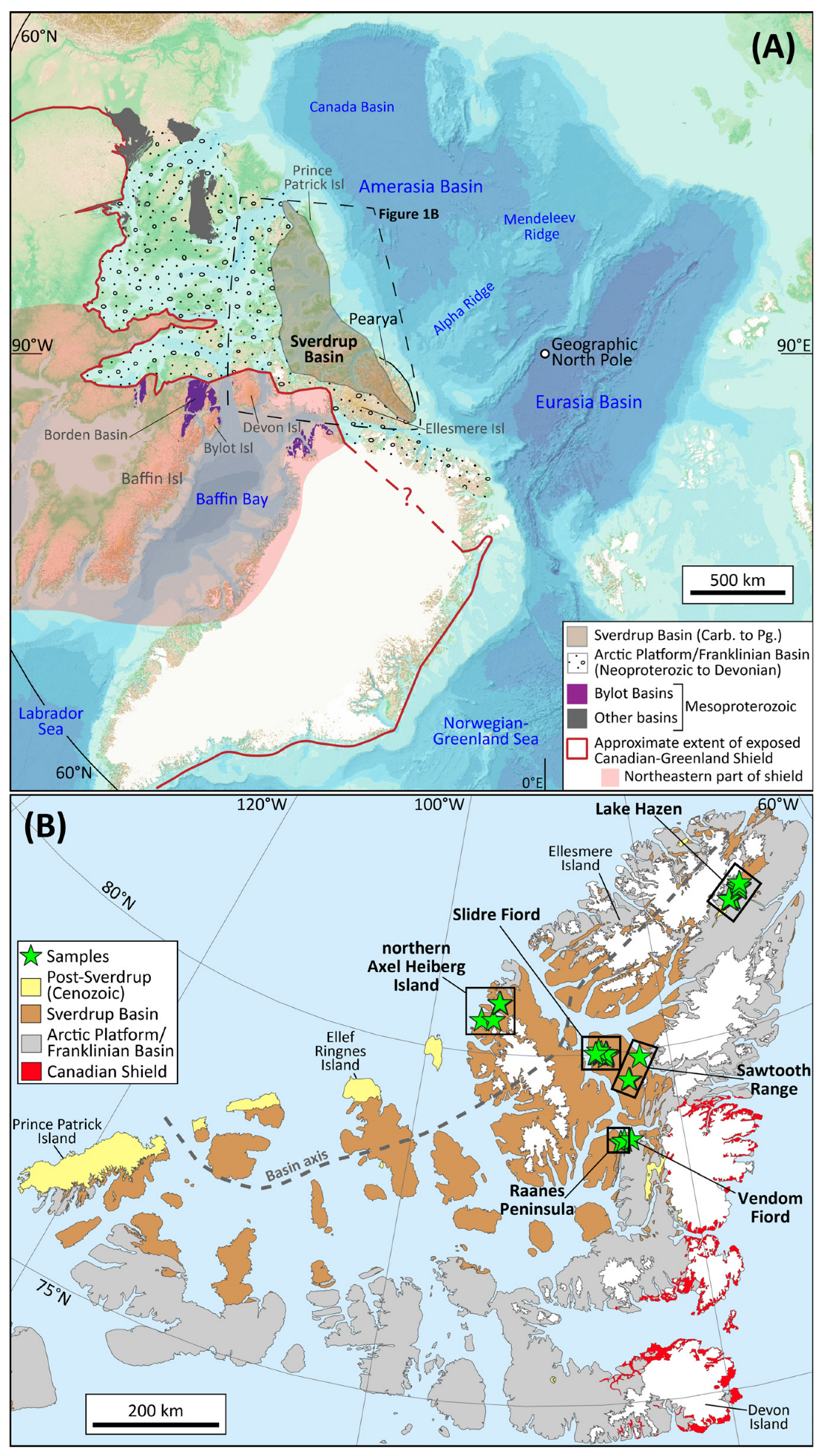
2. Geological Background
Sverdrup Basin
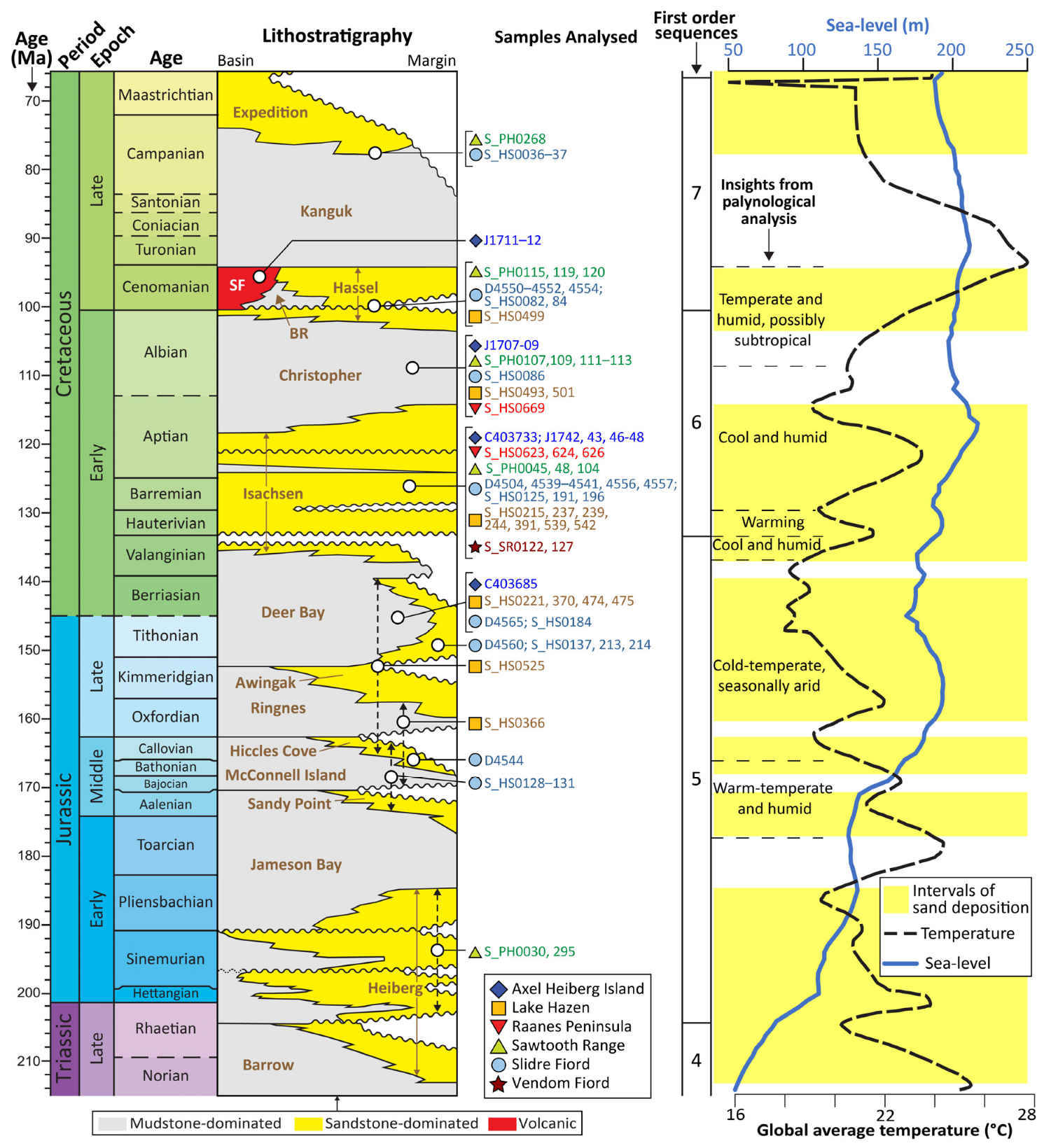
3. Materials and Methods
3.1. Samples
3.2. Methods
3.2.1. Optical Petrographic Analysis
3.2.2. Conventional Heavy Mineral Analysis
3.2.3. Mineral Grain Chemical Analysis
3.2.4. Detrital Zircon U–Pb Geochronology
3.2.5. Detrital Zircon Lu–Hf Isotope Analysis
4. Results
4.1. Optical Petrographic Analysis
4.2. Conventional Heavy Mineral Analysis
4.3. Apatite Chemistry
4.4. Garnet Chemistry
4.5. Rutile Chemistry
4.6. Detrital Zircon U–Pb Geochronology
4.7. Detrital Zircon Lu–Hf Isotopes
5. Discussion
5.1. Sediment Provenance
5.1.1. Middle Jurassic to Early Aptian (Wilkie Point Group to Isachsen Formation)
5.1.2. Late Aptian to Albian (Christopher Formation)
5.1.3. Late Albian to Cenomanian (Hassel and Strand Fiord Formations)
5.1.4. Campanian (Upper Kanguk Formation to Lower Expedition Formation)
5.2. Regional Implications
6. Conclusions
Supplementary Materials
Author Contributions
Funding
Data Availability Statement
Acknowledgments
Conflicts of Interest
References
- Burden, E.T.; Langille, A.B. Stratigraphy and sedimentology of Cretaceous and Paleocene strata in half-grabens on the southeast coast of Baffin Island, Northwest Territories. Bull. Can. Pet. Geol. 1990, 38, 185–196. [Google Scholar]
- Haggart, J.W.; Dafoe, L.T.; Bell, K.M.; Williams, G.L.; Burden, E.T.; Currie, L.D.; Fensome, R.A.; Sweet, A.R. Historical development of a litho- and biostratigraphic framework for onshore Cretaceous-Paleocene deposits along western Baffin Bay. Geol. Surv. Can. Bull. 2022, 608, 107–135. [Google Scholar]
- Miall, A.D.; Balkwill, H.; Hopkins, W.S. Cretaceous and Tertiary Sediments of Eclipse Trough, Bylot Island Area, Arctic Canada, and Their Regional Setting. Geol. Surv. Can. Pap. 1980, 79, 1–20. [Google Scholar]
- Patchett, P.J.; Embry, A.F.; Ross, G.M.; Beauchamp, B.; Harrison, J.C.; Mayr, U.; Isachsen, C.E.; Rosenberg, E.J.; Spence, G.O. Sedimentary Cover of the Canadian Shield through Mesozoic Time Reflected by Nd Isotopic and Geochemical Results for the Sverdrup Basin, Arctic Canada. J. Geol. 2004, 112, 39–57. [Google Scholar] [CrossRef]
- Harrison, J.C.; St-Onge, M.; Petrov, O.; Strelnikov, S.; Lopatin, B.; Wilson, F.; Tella, S.; Paul, D.; Lynds, T.; Shokalsky, S. Geological Map of the Arctic; Geological Survey of Canada: Ottawa, ON, Canada, 2011; Map 2159A.
- Anfinson, O.A.; Leier, A.L.; Dewing, K.; Guest, B.; Stockli, D.F.; Embry, A.F. Insights into the Phanerozoic tectonic evolution of the northern Laurentian margin: Detrital apatite and zircon (U–Th)/He ages from Devonian strata of the Franklinian Basin, Canadian Arctic Islands. Can. J. Earth Sci. 2013, 50, 761–768. [Google Scholar] [CrossRef]
- Grist, A.M.; Zentilli, M. The thermal history of the Nares Strait, Kane Basin, and Smith Sound region in Canada and Greenland: Constraints from apatite fission-track and (U-Th-Sm)/He dating. Can. J. Earth Sci. 2005, 42, 1547–1569. [Google Scholar] [CrossRef]
- Grist, A.M.; Zentilli, M. Preliminary Apatite Fission Track Thermal History Modelling of the Nares Region of Eastern Ellesmere Island and Northwestern Greenland. Polarforschung 2006, 74, 113–127. [Google Scholar]
- McDannell, K.T.; Schneider, D.A.; Zeitler, P.K.; O’Sullivan, P.B.; Issler, D.R. Reconstructing deep-time histories from integrated thermochronology: An example from southern Baffin Island, Canada. Terra Nova 2019, 31, 189–204. [Google Scholar] [CrossRef]
- McGregor, E.D.; Nielsen, S.B.; Stephenson, R.A.; Petersen, K.D.; MacDonald, D.I.M. Long-term exhumation of a Palaeoproterozoic orogen and the role of pre-existing heterogeneous thermal crustal properties: A fission-track study of SE Baffin Island. J. Geol. Soc. 2013, 170, 877–891. [Google Scholar] [CrossRef]
- Spiegel, C.; Sohi, M.S.; Reiter, W.; Meier, K.; Ventura, B.; Lisker, F.; Estrada, S.; Piepjohn, K.; Berglar, K.; Koglin, N.; et al. Phanerozoic Tectonic and Sedimentation History of the Arctic: Constraints From Deep-Time Low-Temperature Thermochronology Data of Ellesmere Island and Northwest Greenland. Tectonics 2023, 42, e2022TC007579. [Google Scholar] [CrossRef]
- Allen, P.A. From landscapes into geological history. Nature 2008, 451, 274–276. [Google Scholar] [CrossRef]
- Caracciolo, L. Sediment generation and sediment routing systems from a quantitative provenance analysis perspective: Review, application and future development. Earth Sci. Rev. 2020, 209, 103226. [Google Scholar] [CrossRef]
- Whittaker, A.C.; Attal, M.; Allen, P.A. Characterising the origin, nature and fate of sediment exported from catchments perturbed by active tectonics. Basin Res. 2010, 22, 809–828. [Google Scholar] [CrossRef]
- Embry, A.F.; Beauchamp, B. Sverdrup Basin. In The Sedimentary Basins of the United States and Canada, 2nd ed.; Miall, A.D., Ed.; Elsevier: Amsterdam, The Netherlands, 2019; pp. 559–592. [Google Scholar]
- Embry, A.F. Mesozoic History of the Arctic Islands. In Geology of the Innuitian Orogen and Arctic Platform of Canada and Greenland; Trettin, H.P., Ed.; Geology of Canada no. 3; Geological Survey of Canada: Ottawa, ON, Canada, 1991; pp. 371–433. [Google Scholar]
- Galloway, B.J.; Dewing, K.; Beauchamp, B.; Matthews, W. Upper Paleozoic stratigraphy and detrital zircon geochronology along the northwest margin of the Sverdrup Basin, Arctic Canada: Insight into the paleogeographic and tectonic evolution of Crockerland. Can. J. Earth Sci. 2021, 58, 164–187. [Google Scholar] [CrossRef]
- Anfinson, O.A.; Embry, A.F.; Stockli, D.F. Geochronologic Constraints on the Permian–Triassic Northern Source Region of the Sverdrup Basin, Canadian Arctic Islands. Tectonophysics 2016, 691, 206–219. [Google Scholar] [CrossRef]
- Hadlari, T.; Dewing, K.; Matthews, W.A.; Alonso-Torres, D.; Midwinter, D. Early Triassic development of a foreland basin in the Canadian high Arctic: Implications for a Pangean Rim of Fire. Tectonophysics 2018, 736, 75–84. [Google Scholar] [CrossRef]
- Midwinter, D.; Hadlari, T.; Davis, W.J.; Dewing, K.; Arnott, R.W.C. Dual provenance signatures of the Triassic northern Laurentian margin from detrital-zircon U-Pb and Hf-isotope analysis of Triassic–Jurassic strata in the Sverdrup Basin. Lithosphere 2016, 8, 668–683. [Google Scholar] [CrossRef]
- Midwinter, D.; Hadlari, T.; Dewing, K.; Matthews, W.A. Disruption and localization of sediment pathways by continental extension: Detrital-zircon provenance change from upper Triassic to lower Jurassic in the northern Sverdrup Basin, Nunavut. Geol. Mag. 2024, 160, 2057–2066. [Google Scholar] [CrossRef]
- Miller, E.L.; Toro, J.; Gehrels, G.; Amato, J.M.; Prokopiev, A.; Tuchkova, M.I.; Akinin, V.V.; Dumitru, T.A.; Moore, T.E.; Cecile, M.P. New insights into Arctic paleogeography and tectonics from U-Pb detrital zircon geochronology. Tectonics 2006, 25, TC3013. [Google Scholar] [CrossRef]
- Omma, J.E.; Pease, V.; Scott, R.A. U–Pb SIMS zircon geochronology of Triassic and Jurassic sandstones on northwestern Axel Heiberg Island, northern Sverdrup Basin, Arctic Canada. In Arctic Petroleum Geology: Geological Society, London, Memoir; Spencer, A.M., Embry, A.F., Gautier, D.L., Stoupakova, A.V., Sørensen, K., Eds.; Geological Society of London: London, UK, 2011; Volume 35, pp. 559–566. [Google Scholar]
- Røhr, T.S.; Davis, W.; Andersen, T.; Dypvik, H.; Embry, A.F. Detrital zircon characteristics of the Lower Cretaceous Isachsen Formation, Sverdrup Basin: Source constraints from age and Hf isotope data. Can. J. Earth Sci. 2010, 47, 255–271. [Google Scholar] [CrossRef]
- Alonso-Torres, D.; Beauchamp, B.; Guest, B.; Hadlari, T.; Matthews, W. Late Paleozoic to Triassic arc magmatism north of the Sverdrup Basin in the Canadian Arctic: Evidence from detrital zircon U-Pb geochronology. Lithosphere 2018, 10, 426–445. [Google Scholar] [CrossRef]
- Jakobsson, M.; Mayer, L.A.; Bringensparr, C.; Castro, C.F.; Mohammad, R.; Johnson, P.; Ketter, T.; Accettella, D.; Amblas, D.; An, L.; et al. The International Bathymetric Chart of the Arctic Ocean Version 4.0. Sci. Data 2020, 7, 176. [Google Scholar] [CrossRef] [PubMed]
- Jackson, G.; Iannelli, T. Rift-related cyclic sedimentation in the Neohelikian Borden Basin, northern Baffin Island. Geol. Surv. Can. Pap. 1981, 81, 269–302. [Google Scholar]
- Pointon, M.A.; Smyth, H.; Omma, J.E.; Morton, A.C.; Schneider, S.; Hülse, P.; Rippington, S.J.; Lopez-Mir, B.; Crowley, Q.G.; Millar, I.; et al. A Multi-proxy Provenance Study of Late Carboniferous to Middle Jurassic Sandstones in the Eastern Sverdrup Basin and Its Bearing on Arctic Palaeogeographic Reconstructions. Geosciences 2023, 13, 10. [Google Scholar] [CrossRef]
- Balkwill, H.R. Evolution of Sverdrup Basin, Arctic Canada. Am. Assoc. Pet. Geol. Bull. 1978, 62, 1004–1028. [Google Scholar]
- Frisch, T. Reconnaissance Geology of the Precambrian Shield of Ellesmere, Devon and Coburg Islands, Arctic Archipelago: A Preliminary Account. Geol. Surv. Can. Pap. 1983, 82, 1–11. [Google Scholar]
- Frisch, T.; Hunt, P.A. U-Pb Zircon and Monazite Ages from the Precambrian Shield of Ellesmere and Devon Islands, Artic Archipelago. Geol. Surv. Can. Pap. 1988, 88, 117–125. [Google Scholar]
- St-Onge, M.R.; Van Gool, J.A.M.; Garde, A.A.; Scott, D.J. Correlation of Archaean and Palaeoproterozoic units between northeastern Canada and western Greenland: Constraining the pre-collisional upper plate accretionary history of the Trans-Hudson orogen. In Earth Accretionary Systems in Space and Time: Geological Society, London, Special Publication; Cawood, P.A., Kröner, A., Eds.; Geological Society of London: London, UK, 2009; Volume 318, pp. 193–235. [Google Scholar]
- Dawes, P.R. The proterozoic thule supergroup, Greenland and Canada: History, lithostratigraphy and development. Geol. Greenl. Surv. Bull. 1997, 174, 1–150. [Google Scholar] [CrossRef]
- Turner, E.C.; Long, D.G.F.; Rainbird, R.H.; Petrus, J.A.; Rayner, N.M. Late Mesoproterozoic rifting in Arctic Canada during Rodinia assembly: Impactogens, trans-continental far-field stress and zinc mineralisation. Terra Nova 2016, 28, 188–194. [Google Scholar] [CrossRef]
- Fahrig, W.; Christie, K.; Jones, D. Paleomagnetism of the Bylot basins: Evidence for Mackenzie continental tensional tectonics. Geol. Surv. Can. Pap. 1981, 81, 303–312. [Google Scholar]
- Thorsteinsson, R.; Tozer, E. Summary Account of Structural History of the Canadian Arctic Archipelago Since Precambrian Time. Geol. Surv. Can. Pap. 1960, 60–67, 1–25. [Google Scholar]
- Trettin, H.P. The Proterozoic to Late Silurian Record of Pearya. In Geology of the Innuitian Orogen and Arctic Platform of Canada and Greenland; Trettin, H.P., Ed.; Geology of Canada no.3; Geological Survey of Canada: Ottawa, ON, Canada, 1991; pp. 241–260. [Google Scholar]
- Anfinson, O.A.; Leier, A.L.; Embry, A.F.; Dewing, K. Detrital zircon geochronology and provenance of the Neoproterozoic to Late Devonian Franklinian Basin, Canadian Arctic Islands. Geol. Soc. Am. Bull. 2012, 124, 415–430. [Google Scholar] [CrossRef]
- Anfinson, O.A.; Leier, A.L.; Gaschnig, R.; Embry, A.F.; Dewing, K.; Colpron, M. U–Pb and Hf isotopic data from Franklinian Basin strata: Insights into the nature of Crockerland and the timing of accretion, Canadian Arctic Islands. Can. J. Earth Sci. 2012, 49, 1316–1328. [Google Scholar] [CrossRef]
- Dewing, K.; Hadlari, T. Franklinian Composite Tectono-Sedimentary Element, Canadian Arctic Islands. In Sedimentary Successions of the Arctic Region and Their Hydrocarbon Prospectivity: Geological Society, London, Memoir; Drachev, S.S., Brekke, H., Henriksen, E., Moore, T., Eds.; Geological Society of London: London, UK, 2024; Volume 57, M57–2016-2014. [Google Scholar]
- Thorsteinsson, R.; Tozer, E. Geology of the Arctic archipelago. In Geology and Economic Minerals of Canada: Econmic Geology Report No. 1, 5th ed.; Douglas, R.J.W., Ed.; Department of Energy, Mines and Resources: Ottawa, ON, Canada, 1970; pp. 547–590. [Google Scholar]
- Beranek, L.P.; Pease, V.; Scott, R.A.; Thomsen, T.B.; Mahoney, J.B. Detrital zircon geochronology of Ediacaran to Cambrian deep-water strata of the Franklinian basin, northern Ellesmere Island, Nunavut: Implications for regional stratigraphic correlations. Can. J. Earth Sci. 2013, 50, 1007–1018. [Google Scholar] [CrossRef]
- Dewing, K.; Harrison, J.C.; Pratt, B.R.; Mayr, U. A probable late Neoproterozoic age for the Kennedy Channel and Ella Bay formations, northeastern Ellesmere Island and its implications for passive margin history of the Canadian Arctic. Can. J. Earth Sci. 2004, 41, 1013–1025. [Google Scholar] [CrossRef]
- Trettin, H.P.; Mayr, U.; Long, G.D.F.; Packard, J.J. Cambrian to Early Devonian Basin Development, Sedimentation, and Volcanism, Arctic Islands. In Geology of the Innuitian Orogen and Arctic Platform of Canada and Greenland; Trettin, H.P., Ed.; Geology of Canada no. 3; Geological Survey of Canada: Ottawa, ON, Canada, 1991; pp. 165–238. [Google Scholar]
- Patchett, P.J.; Roth, M.A.; Canale, B.S.; de Freitas, T.A.; Harrison, J.C.; Embry, A.F.; Ross, G.M. Nd isotopes, geochemistry, and constraints on sources of sediments in the Franklinian mobile belt, Arctic Canada. GSA Bull. 1999, 111, 578–589. [Google Scholar] [CrossRef]
- Beranek, L.P.; Pease, V.; Hadlari, T.; Dewing, K. Silurian flysch successions of Ellesmere Island, Arctic Canada, and their significance to northern Caledonian palaeogeography and tectonics. J. Geol. Soc. 2015, 172, 201–212. [Google Scholar] [CrossRef]
- Embry, A.F. Middle-Upper Devonian Clastic Wedge of the Arctic Islands. In Geology of the Innuitian Orogen and Arctic Platform of Canada and Greenland; Trettin, H.P., Ed.; Geology of Canada no. 3; Geological Survey of Canada: Ottawa, ON, Canada, 1991; pp. 263–280. [Google Scholar]
- Embry, A.F. Middle-Upper Devonian sedimentation in the Canadian Arctic Islands and the Ellesmerian Orogeny. In Devonian of the World: Proceedings of the 2nd International Symposium on the Devonian System—Volume II: Sedimentation: Canadian Society of Petroleum Geologists, Memoir; McMillan, N.J., Embry, A.F., Glass, D.J., Eds.; Canadian Society of Petroleum Geologists: Calgary, AB, Canada, 1988; Volume 14, pp. 15–28. [Google Scholar]
- Embry, A.F.; Klovan, J.E. The Middle-Upper Devonian clastic wedge of the Franklinian geosyncline. Bull. Can. Pet. Geol. 1976, 24, 485–639. [Google Scholar]
- Embry, A.F. Petroleum prospectivity of the Triassic–Jurassic succession of Sverdrup Basin, Canadian Arctic Archipelago. In Arctic Petroleum Geology: Geological Society, London, Memoir; Spencer, A.M., Embry, A.F., Gautier, D.L., Stoupakova, A.V., Sørensen, K., Eds.; Geological Society of London: London, UK, 2011; Volume 35, pp. 545–558. [Google Scholar]
- Stephenson, R.; Boerstoel, J.; Embry, A.F.; Ricketts, B.D. Subsidence analysis and tectonic modeling of the Sverdrup Basin. In 1992 Proceedings, International Conference on Arctic Margins; Thurston, D.K., Fujita, K., Eds.; U.S. Department of the Interior, Minerals Management Service: Anchorage, AK, USA, 1994; pp. 149–154. [Google Scholar]
- Lopez-Mir, B.; Schneider, S.; Hülse, P. Fault activity and diapirism in the Mississippian to Late Cretaceous Sverdrup Basin: New insights into the tectonic evolution of the Canadian Arctic. J. Geodyn. 2018, 118, 55–65. [Google Scholar] [CrossRef]
- Hadlari, T.; Midwinter, D.; Galloway, J.M.; Dewing, K.; Durbano, A.M. Mesozoic rift to post-rift tectonostratigraphy of the Sverdrup Basin, Canadian Arctic. Mar. Pet. Geol. 2016, 76, 148–158. [Google Scholar] [CrossRef]
- Boutelier, J.; Cruden, A.; Brent, T.; Stephenson, R. Timing and mechanisms controlling evaporite diapirism on Ellef Ringnes Island, Canadian Arctic Archipelago. Basin Res. 2011, 23, 478–498. [Google Scholar] [CrossRef]
- Harrison, J.C.; Jackson, M.P.A. Exposed evaporite diapirs and minibasins above a canopy in central Sverdrup Basin, Axel Heiberg Island, Arctic Canada. Basin Res. 2014, 26, 567–596. [Google Scholar] [CrossRef]
- Jackson, M.P.A.; Harrison, J.C. An allochthonous salt canopy on Axel Heiberg Island, Sverdrup Basin, Arctic Canada. Geology 2006, 34, 1045–1048. [Google Scholar] [CrossRef]
- Embry, A.F.; Dixon, J. The age of the Amerasia Basin. In 1992 Proceedings, International Conference on Arctic Margins; Thurston, D.K., Fujita, K., Eds.; U.S. Department of the Interior, Minerals Management Service: Anchorage, AK, USA, 1994; pp. 289–295. [Google Scholar]
- Harrison, J.C.; Brent, T.A. Basins and fold belts of Prince Patrick Island and adjacent areas, Canadian Arctic Islands. Geol. Surv. Can. Bull. 2005, 560, 1–208. [Google Scholar]
- Ricketts, B. Basin analysis, Eureka Sound Group, Axel Heiberg and Ellesmere Islands, Canadian Arctic archipelago. Geol. Surv. Can. Mem. 1994, 439, 1–119. [Google Scholar]
- Piepjohn, K.; von Gosen, W.; Tessensohn, F. The Eurekan deformation in the Arctic: An outline. J. Geol. Soc. 2016, 173, 1007–1024. [Google Scholar] [CrossRef]
- Vaes, B.; van Hinsbergen, D.J.J.; van de Lagemaat, S.H.A.; van der Wiel, E.; Lom, N.; Advokaat, E.L.; Boschman, L.M.; Gallo, L.C.; Greve, A.; Guilmette, C.; et al. A global apparent polar wander path for the last 320 Ma calculated from site-level paleomagnetic data. Earth Sci. Rev. 2023, 245, 104547. [Google Scholar] [CrossRef]
- van Hinsbergen, D.J.J.; de Groot, L.V.; van Schaik, S.J.; Spakman, W.; Bijl, P.K.; Sluijs, A.; Langereis, C.G.; Brinkhuis, H. A Paleolatitude Calculator for Paleoclimate Studies. PLoS ONE 2015, 10, e0126946. [Google Scholar] [CrossRef] [PubMed]
- Galloway, J.M.; Sweet, A.R.; Swindles, G.T.; Dewing, K.; Hadlari, T.; Embry, A.F.; Sanei, H. Middle Jurassic to Lower Cretaceous paleoclimate of Sverdrup Basin, Canadian Arctic Archipelago inferred from the palynostratigraphy. Mar. Pet. Geol. 2013, 44, 240–255. [Google Scholar] [CrossRef]
- Wang, Y.; Huang, C.; Sun, B.; Quan, C.; Wu, J.; Lin, Z. Paleo-CO2 variation trends and the Cretaceous greenhouse climate. Earth Sci. Rev. 2014, 129, 136–147. [Google Scholar] [CrossRef]
- Hallam, A. A review of Mesozoic climates. J. Geol. Soc. 1985, 142, 433–445. [Google Scholar] [CrossRef]
- Sellwood, B.W.; Valdes, P.J. Mesozoic climates: General circulation models and the rock record. Sediment. Geol. 2006, 190, 269–287. [Google Scholar] [CrossRef]
- Kemper, E.; Schmitz, H.H. Stellate Nodules from the Upper Deer Bay Formation (Valanginian) of Arctic Canada. Geol. Surv. Can. Pap. 1975, 75–1C, 109–119. [Google Scholar]
- Schneider, S.; Kelly, S.R.A.; Mutterlose, J.; Herrle, J.O.; Hülse, P.; Jolley, D.W.; Schröder-Adams, C.J.; Lopez-Mir, B. Macrofauna and biostratigraphy of the Rollrock Section, northern Ellesmere Island, Canadian Arctic Islands—A comprehensive high latitude archive of the Jurassic–Cretaceous transition. Cretac. Res. 2020, 114, 104508. [Google Scholar] [CrossRef]
- Grasby, S.E.; McCune, G.E.; Beauchamp, B.; Galloway, J.M. Lower Cretaceous cold snaps led to widespread glendonite occurrences in the Sverdrup Basin, Canadian High Arctic. GSA Bull. 2017, 129, 771–787. [Google Scholar] [CrossRef]
- Price, G.D. The evidence and implications of polar ice during the Mesozoic. Earth Sci. Rev. 1999, 48, 183–210. [Google Scholar] [CrossRef]
- Nguyen, A.V.; Galloway, J.M.; Poulton, T.P.; Dutchak, A.R. Calibration of Middle to Upper Jurassic palynostratigraphy with Boreal ammonite zonations in the Canadian Arctic. Bull. Can. Pet. Geol. 2020, 68, 65–90. [Google Scholar]
- Galloway, J.M.; Tullius, D.N.; Evenchick, C.A.; Swindles, G.T.; Hadlari, T.; Embry, A. Early Cretaceous vegetation and climate change at high latitude: Palynological evidence from Isachsen Formation, Arctic Canada. Cretac. Res. 2015, 56, 399–420. [Google Scholar] [CrossRef]
- Hopkins, W.S., Jr.; Balkwill, H.R. Description, Palynology and Paleoecology of the Hassel Formation (Cretaceous) on Eastern Ellef Ringnes Island, District of Franklin. Geol. Surv. Can. Pap. 1973, 72, 1–21. [Google Scholar]
- Sulphur, K.C. Quantitative Palynological Analyses of Albian-Cenomanian (Lower to Upper Cretaceous) Strata in the Sverdrup Basin: Insights into Paleoecology, Paleoclimatology and Palynostratigraphy. Master’s Thesis, University of Calgary, Calgary, AB, Canada, 2015. [Google Scholar]
- Embry, A.F.; Osadetz, K.G. Stratigraphy and tectonic significance of Cretaceous volcanism in the Queen Elizabeth Islands, Canadian Arctic Archipelago. Can. J. Earth Sci. 1988, 25, 1209–1219. [Google Scholar] [CrossRef]
- Dockman, D.M.; Pearson, D.G.; Heaman, L.M.; Gibson, S.A.; Sarkar, C. Timing and origin of magmatism in the Sverdrup Basin, Northern Canada—Implications for lithospheric evolution in the High Arctic Large Igneous Province (HALIP). Tectonophysics 2018, 742–743, 50–65. [Google Scholar] [CrossRef]
- Estrada, S. Geochemical and Sr–Nd isotope variations within Cretaceous continental flood-basalt suites of the Canadian High Arctic, with a focus on the Hassel Formation basalts of northeast Ellesmere Island. Int. J. Earth Sci. 2015, 104, 1981–2005. [Google Scholar] [CrossRef]
- Estrada, S.; Damaske, D.; Henjes-Kunst, F.; Schreckenberger, B.; Oakey, G.N.; Piepjohn, K.; Eckelmann, K.; Linnemann, U. Multistage Cretaceous magmatism in the northern coastal region of Ellesmere Island and its relation to the formation of Alpha Ridge—Evidence from aeromagnetic, geochemical and geochronological data. Norw. J. Geol. 2016, 96, 65–95. [Google Scholar] [CrossRef]
- Estrada, S.; Henjes-Kunst, F. 40Ar-39Ar and U-Pb dating of Cretaceous continental rift-related magmatism on the northeast Canadian Arctic margin. Z. Dtsch. Ges. Geowiss. 2013, 164, 107–130. [Google Scholar] [CrossRef] [PubMed]
- Evenchick, C.A.; Davis, W.J.; Bédard, J.H.; Hayward, N.; Friedman, R.M. Evidence for protracted High Arctic large igneous province magmatism in the central Sverdrup Basin from stratigraphy, geochronology, and paleodepths of saucer-shaped sills. GSA Bull. 2015, 127, 1366–1390. [Google Scholar] [CrossRef]
- Maher, J.H.D. Manifestations of the Cretaceous High Arctic Large Igneous Province in Svalbard. J. Geol. 2001, 109, 91–104. [Google Scholar] [CrossRef]
- Naber, T.V.; Grasby, S.E.; Cuthbertson, J.P.; Rayner, N.; Tegner, C. New constraints on the age, geochemistry, and environmental impact of High Arctic Large Igneous Province magmatism: Tracing the extension of the Alpha Ridge onto Ellesmere Island, Canada. GSA Bull. 2020, 133, 1695–1711. [Google Scholar] [CrossRef]
- Bédard, J.H.; Troll, V.R.; Deegan, F.M.; Tegner, C.; Saumur, B.M.; Evenchick, C.A.; Grasby, S.E.; Dewing, K. High Arctic Large Igneous Province Alkaline Rocks in Canada: Evidence for Multiple Mantle Components. J. Petrol. 2021, 62, 1–31. [Google Scholar] [CrossRef]
- Osadetz, K.; Moore, P.R. Basic Volcanics in the Hassel Formation (Mid-Cretaceous) and Associated Intrusives, Ellesmere Island, District of Franklin, Northwest Territories. Geol. Surv. Can. Pap. 1988, 87, 1–19. [Google Scholar]
- Jowitt, S.M.; Williamson, M.-C.; Ernst, R.E. Geochemistry of the 130 to 80 Ma Canadian High Arctic Large Igneous Province (HALIP) Event and Implications for Ni-Cu-PGE Prospectivity. Econ. Geol. 2014, 109, 281–307. [Google Scholar] [CrossRef]
- Estrada, S.; Henjes-Kunst, F. Volcanism in the Canadian. Zeitschrift der Deutschen Geologischen Gesellschaft 2004, 154, 579–603. [Google Scholar] [CrossRef]
- Kingsbury, C.G.; Kamo, S.L.; Ernst, R.E.; Söderlund, U.; Cousens, B.L. U-Pb geochronology of the plumbing system associated with the Late Cretaceous Strand Fiord Formation, Axel Heiberg Island, Canada: Part of the 130–90 Ma High Arctic large igneous province. J. Geodyn. 2018, 118, 106–117. [Google Scholar] [CrossRef]
- Tarduno, J.A.; Brinkman, D.B.; Renne, P.R.; Cottrell, R.D.; Scher, H.; Castillo, P. Evidence for Extreme Climatic Warmth from Late Cretaceous Arctic Vertebrates. Science 1998, 282, 2241–2243. [Google Scholar] [CrossRef] [PubMed]
- Villeneuve, M.; Williamson, M.-C. 40Ar-39Ar dating of mafic magmatism from the Sverdrup Basin magmatic province. In Proceedings of the Fourth International Conference on Arctic Margins; Scott, R.A., Thurston, D.K., Eds.; U.S. Department of the Interior, Minerals Management Service: Anchorage, AK, USA, 2003; pp. 206–216. [Google Scholar]
- Davis, W.J.; Schröder-Adams, C.J.; Galloway, J.M.; Herrle, J.O.; Pugh, A.T. U–Pb geochronology of bentonites from the Upper Cretaceous Kanguk Formation, Sverdrup Basin, Arctic Canada: Constraints on sedimentation rates, biostratigraphic correlations and the late magmatic history of the High Arctic Large Igneous Province. Geol. Mag. 2017, 154, 757–776. [Google Scholar] [CrossRef]
- Pointon, M.A.; Flowerdew, M.J.; Hülse, P.; Schneider, S.; Whitehouse, M.J. Mixed local and ultra-distal volcanic ash deposition within the Upper Cretaceous Kanguk Formation, Sverdrup Basin, Canadian Arctic Islands. Geol. Mag. 2019, 156, 2067–2084. [Google Scholar] [CrossRef]
- Reinhardt, L.; Estrada, S.; Andruleit, H.; Dohrmann, R.; Piepjohn, K.; von Gosen, W.; Davis, D.W.; Davis, B. Altered volcanic ashes in Palaeocene and Eocene sediments of the Eureka Sound Group (Ellesmere Island, Nunavut, Arctic Canada). Z. Dtsch. Ges. Geowiss. 2013, 164, 131–147. [Google Scholar] [CrossRef]
- Scotese, C.R.; Song, H.; Mills, B.J.W.; van der Meer, D.G. Phanerozoic paleotemperatures: The earth’s changing climate during the last 540 million years. Earth Sci. Rev. 2021, 215, 103503. [Google Scholar] [CrossRef]
- van der Meer, D.G.; Scotese, C.R.; Mills, B.J.W.; Sluijs, A.; van den Berg van Saparoea, A.-P.; van de Weg, R.M.B. Long-term Phanerozoic global mean sea level: Insights from strontium isotope variations and estimates of continental glaciation. Gondwana Res. 2022, 111, 103–121. [Google Scholar] [CrossRef]
- Hadlari, T. Rift to Post-Rift Tectonostratigraphy of the Sverdrup Basin in Relation to Onset of the High Arctic Large Igneous Province (HALIP) in the Early Cretaceous, Arctic Canada. Geochem. Geophys. Geosyst. 2024, 25, e2023GC011411. [Google Scholar] [CrossRef]
- Embry, A.F. The Wilkie Point Group (Lower-Upper Jurassic), Sverdrup Basin, Arctic Islands. Geol. Surv. Can. Pap. 1984, 84–1B, 299–308. [Google Scholar]
- Cohen, K.M.; Finney, S.C.; Gibbard, P.L.; Fan, J.-X. The ICS international chronostratigraphic chart. Episodes 2013, 36, 199–204. [Google Scholar] [CrossRef]
- Ricketts, B. New formations in the Eureka Sound Group, Canadian Arctic Islands. Geol. Surv. Can. Pap. 1986, 86–1B, 363–374. [Google Scholar]
- Galloway, J.M.; Sweet, A.R.; Pugh, A.; Schröder-Adams, C.J.; Swindles, G.T.; Haggart, J.W.; Embry, A.F. Correlating middle Cretaceous palynological records from the Canadian High Arctic based on a section from the Sverdrup Basin and samples from the Eclipse Trough. Palynology 2012, 36, 277–302. [Google Scholar] [CrossRef]
- Ingersoll, R.V.; Bullard, T.F.; Ford, R.L.; Grimm, J.P.; Pickle, J.D.; Sares, S.W. The effect of grain size on detrital modes: A test of the Gazzi-Dickinson point-counting method. J. Sediment. Res. 1984, 54, 103–116. [Google Scholar]
- Folk, R.L. Petrology of Sedimentary Rocks; Hemphill Publishing Company: Austin, TX, USA, 1980; pp. 1–182. [Google Scholar]
- Pettijohn, F.J.; Potter, P.E.; Siever, R. Sand and Sandstone; Springer: New York, NY, USA, 1987; pp. 1–553. [Google Scholar]
- Morton, A.C. Chapter 8: Value of heavy minerals in sediments and sedimentary rocks for provenance, transport history and stratigraphic correlation. In Quantitative Mineralogy and Microanalysis of Sediments and Sedimentary Rocks: Mineralogical Association of Canada Short Course; Sylvester, P., Ed.; Mineralogical Association of Canada: Quebec, QC, Canada, 2012; Volume 42, pp. 133–165. [Google Scholar]
- Morton, A.C.; Hallsworth, C. Identifying provenance-specific features of detrital heavy mineral assemblages in sandstones. Sediment. Geol. 1994, 90, 241–256. [Google Scholar] [CrossRef]
- Galehouse, J.S. Point counting. In Procedures in Sedimentary Petrology; Carver, R.E., Ed.; John Wiley & Sons: Hoboken, NJ, USA, 1971; pp. 385–407. [Google Scholar]
- O’Sullivan, G.J.; Chew, D.; Kenny, G.; Henrichs, I.; Mulligan, D. The trace element composition of apatite and its application to detrital provenance studies. Earth Sci. Rev. 2020, 201, 103044. [Google Scholar] [CrossRef]
- Meinhold, G.; Anders, B.; Kostopoulos, D.; Reischmann, T. Rutile chemistry and thermometry as provenance indicator: An example from Chios Island, Greece. Sediment. Geol. 2008, 203, 98–111. [Google Scholar] [CrossRef]
- Watson, E.B.; Wark, D.A.; Thomas, J.B. Crystallization thermometers for zircon and rutile. Contrib. Mineral. Petrol. 2006, 151, 413–433. [Google Scholar] [CrossRef]
- Schönig, J.; von Eynatten, H.; Tolosana-Delgado, R.; Meinhold, G. Garnet major-element composition as an indicator of host-rock type: A machine learning approach using the random forest classifier. Contrib. Mineral. Petrol. 2021, 176, 98. [Google Scholar] [CrossRef]
- Stacey, J.S.; Kramers, J.D. Approximation of terrestrial lead isotope evolution by a two-stage model. Earth Planet. Sci. Lett. 1975, 26, 207–221. [Google Scholar] [CrossRef]
- Ludwig, K.R. On the Treatment of Concordant Uranium-Lead Ages. Geochim. Cosmochim. Acta 1998, 62, 665–676. [Google Scholar] [CrossRef]
- Ludwig, K.R. User’s Manual for Isoplot 3.75: A Geochronological Toolkit for Microsoft Excel; Berkeley Geochronological Centre: Berkeley, CA, USA, 2012; Volume 5, p. 75. [Google Scholar]
- Thomas, R.J.; Spencer, C.; Bushi, A.M.; Baglow, N.; Boniface, N.; de Kock, G.; Horstwood, M.S.A.; Hollick, L.; Jacobs, J.; Kajara, S.; et al. Geochronology of the central Tanzania Craton and its southern and eastern orogenic margins. Precambrian Res. 2016, 277, 47–67. [Google Scholar] [CrossRef]
- Söderlund, U.; Patchett, P.J.; Vervoort, J.D.; Isachsen, C.E. The 176Lu decay constant determined by Lu–Hf and U–Pb isotope systematics of Precambrian mafic intrusions. Earth Planet. Sci. Lett. 2004, 219, 311–324. [Google Scholar] [CrossRef]
- Bouvier, A.; Vervoort, J.D.; Patchett, P.J. The Lu–Hf and Sm–Nd isotopic composition of CHUR: Constraints from unequilibrated chondrites and implications for the bulk composition of terrestrial planets. Earth Planet. Sci. Lett. 2008, 273, 48–57. [Google Scholar] [CrossRef]
- Hamilton, N.E.; Ferry, M. ggtern: Ternary Diagrams Using ggplot2. J. Stat. Softw. Code Snippets 2018, 87, 1–17. [Google Scholar] [CrossRef]
- Andersen, T.; Kristoffersen, M.; Elburg, M.A. Visualizing, interpreting and comparing detrital zircon age and Hf isotope data in basin analysis—A graphical approach. Basin Res. 2017, 30, 132–147. [Google Scholar] [CrossRef]
- Hadlari, T.; Davis, W.J.; Dewing, K. A pericratonic model for the Pearya terrane as an extension of the Franklinian margin of Laurentia, Canadian Arctic. Geol. Soc. Am. Bull. 2014, 126, 182–200. [Google Scholar] [CrossRef]
- Malone, S.J.; McClelland, W.C.; Gosen, W.v.; Piepjohn, K. Detrital zircon U-Pb and Lu-Hf analysis of Paleozoic sedimentary rocks from the Pearya terrane and Ellesmerian Fold Belt (northern Ellesmere Island): A comparison with Circum-Arctic datasets and their implications on terrane tectonics. In Circum-Arctic Structural Events: Tectonic Evolution of the Arctic Margins and Trans-Arctic Links with Adjacent Orogens: Geological Society of America, Special Paper; Piepjohn, K., Strauss, J.V., Reinhardt, L., McClelland, W.C., Eds.; Geological Society of America: Boulder, CO, USA, 2018; Volume 541, pp. 231–254. [Google Scholar]
- Sircombe, K.N. Mountains in the shadows of time: Three-dimensional density distribution mapping of U-Pb isotopic data as a visualization aid for geochronological information in concordia diagrams. Geochem. Geophys. Geosyst. 2006, 7, Q07013. [Google Scholar] [CrossRef]
- Griffin, W.L.; Wang, X.; Jackson, S.E.; Pearson, N.J.; O’Reilly, S.Y.; Xu, X.; Zhou, X. Zircon chemistry and magma mixing, SE China: In-situ analysis of Hf isotopes, Tonglu and Pingtan igneous complexes. Lithos 2002, 61, 237–269. [Google Scholar] [CrossRef]
- Sundell, K.E.; Saylor, J.E. Two-Dimensional Quantitative Comparison of Density Distributions in Detrital Geochronology and Geochemistry. Geochem. Geophys. Geosyst. 2021, 22, e2020GC009559. [Google Scholar] [CrossRef]
- Embry, A.F. Stratigraphic subdivision of the Awingak Formation (Upper Jurassic) and revision of the Hiccles Cove Formation (Middle Jurassic), Sverdrup Basin, Arctic Islands. Geol. Surv. Can. Pap. 1986, 86–1B, 341–349. [Google Scholar]
- Roy, K. Isachsen Formation, Amund Ringnes Island, District of Franklin. Geol. Surv. Can. Pap. 1973, 73, 269–273. [Google Scholar]
- Roy, K. Transport Directions in the Isachsen Formation (Lower Cretaceous), Sverdrup Islands, District of Franklin. Geol. Surv. Can. Pap. 1974, 75, 351–353. [Google Scholar]
- Tullius, D.; Leier, A.; Galloway, J.; Embry, A.; Pedersen, P. Sedimentology and stratigraphy of the Lower Cretaceous Isachsen Formation: Ellef Ringnes Island, Sverdrup Basin, Canadian Arctic Archipelago. Mar. Pet. Geol. 2014, 57, 135–151. [Google Scholar] [CrossRef]
- Embry, A.F. Stratigraphy of the Early Cretaceous Isachsen Formation, Sverdrup Basin and postulated sandstone occurrence on the Arctic continental shelf. In Proceedings of the GeoCanada 2010—Working with the Earth, Calgary, AB, Canada, 10–14 May 2010. [Google Scholar]
- Vermeesch, P. Dissimilarity measures in detrital geochronology. Earth Sci. Rev. 2018, 178, 310–321. [Google Scholar] [CrossRef]
- Beauchamp, B.; Alonso-Torres, D.; Piepjohn, K.; Thériault, P.; Grasby, S.E. Early Carboniferous syn-rift sedimentation in the Sverdrup Basin (Yelverton Pass area, northern Ellesmere Island, Arctic Canada): A solution to the Okse Bay problem. In Circum-Arctic Structural Events: Tectonic Evolution of the Arctic Margins and Trans-Arctic Links with Adjacent Orogens: Geological Society of America, Special Paper; Piepjohn, K., Strauss, J.V., Reinhardt, L., McClelland, W.C., Eds.; Geological Society of America: Boulder, CO, USA, 2018; Volume 541, pp. 255–284. [Google Scholar]
- Vermeesch, P.; Resentini, A.; Garzanti, E. An R package for statistical provenance analysis. Sediment. Geol. 2016, 336, 14–25. [Google Scholar] [CrossRef]
- Frisch, T.; Morgan, W.; Dunning, G. Reconnaissance geology of the Precambrian Shield on Ellesmere and Coburg Islands, Canadian Arctic Archipelago. Geol. Surv. Can. Pap. 1978, 78-1A, 135–138. [Google Scholar]
- Deer, W.A.; Howie, R.A.; Zussman, J. An Introduction to the Rock-Forming Minerals, 3rd ed.; Mineralogical Society of Great Britain and Ireland: London, UK, 2013; pp. 1–498. [Google Scholar]
- Ricketts, B. Delta evolution in the Eureka Sound Group, western Axel Heiberg Island: The transition from wave-dominated to fluvial-dominated deltas. Geol. Surv. Can. Bull. 1991, 402, 1–72. [Google Scholar]
- Núñez-Betelu, L.; Hills, L.; Krause, F.F.; Mclntyre, D. Upper Cretaceous paleoshorelines of the northeastern Sverdrup Basin, Ellesmere Island, Canadian Arctic Archipelago. In 1994 Proceedings, International Conference on Arctic Margins; Simakov, K.V., Thurston, D.K., Eds.; Russian Academy of Sciences Far East Branch: Magadan, Russia, 1994; pp. 43–49. [Google Scholar]
- Morton, A.C.; Hallsworth, C. Chapter 7 Stability of Detrital Heavy Minerals During Burial Diagenesis. In Heavy Minerals in Use: Developments in Sedimentology; Mange, M.A., Wright, D.T., Eds.; Elsevier: Amsterdam, The Netherlands, 2007; Volume 58, pp. 215–245. [Google Scholar]
- Morton, A.C. Influences of provenance and diagenesis on detrital garnet suites in the Paleocene Forties Sandstone, central North Sea. J. Sediment. Res. 1987, 57, 1027–1032. [Google Scholar] [CrossRef]
- Grantz, A.; Hart, P.E.; Childers, V.A. Geology and tectonic development of the Amerasia and Canada Basins, Arctic Ocean. In Arctic Petroleum Geology: Geological Society, London, Memoir; Spencer, A.M., Embry, A.F., Gautier, D.L., Stoupakova, A.V., Sørensen, K., Eds.; Geological Society of London: London, UK, 2011; Volume 35, pp. 771–799. [Google Scholar]
- Nikishin, A.M.; Petrov, E.I.; Cloetingh, S.; Malyshev, N.A.; Morozov, A.F.; Posamentier, H.W.; Verzhbitsky, V.E.; Freiman, S.I.; Rodina, E.A.; Startseva, K.F.; et al. Arctic ocean mega project: Paper 2—Arctic stratigraphy and regional tectonic structure. Earth Sci. Rev. 2021, 217, 103581. [Google Scholar] [CrossRef]
- Miller, E.L.; Meisling, K.E.; Akinin, V.V.; Brumley, K.; Coakley, B.J.; Gottlieb, E.S.; Hoiland, C.W.; O’Brien, T.M.; Soboleva, A.; Toro, J. Circum-Arctic Lithosphere Evolution (CALE) Transect C: Displacement of the Arctic Alaska–Chukotka microplate towards the Pacific during opening of the Amerasia Basin of the Arctic. In Circum-Arctic Lithosphere Evolution: Geological Society, London, Special Publication; Pease, V., Coakley, B., Eds.; Geological Society of London: London, UK, 2018; Volume 460, pp. 57–120. [Google Scholar]
- Alvey, A.; Gaina, C.; Kusznir, N.J.; Torsvik, T.H. Integrated crustal thickness mapping and plate reconstructions for the high Arctic. Earth Planet. Sci. Lett. 2008, 274, 310–321. [Google Scholar] [CrossRef]
- Shephard, G.E.; Müller, R.D.; Seton, M. The tectonic evolution of the Arctic since Pangea breakup: Integrating constraints from surface geology and geophysics with mantle structure. Earth Sci. Rev. 2013, 124, 148–183. [Google Scholar] [CrossRef]
- Embry, A.F. Crockerland—The northwest source area for the Sverdrup Basin, Canadian Arctic Islands. In Arctic Geology and Petroleum Potential: Norwegian Petroleum Society, Special Publication; Vorren, T.O., Bergsager, E., Dahl-Stamnes, Ø.A., Holter, E., Johansen, B., Lie, E., Lund, T.B., Eds.; Norwegian Petroleum Society: Stavanger, Norway, 1993; Volume 2, pp. 205–216. [Google Scholar]
- Harrison, J.C.; Embry, A.F.; Poulton, T.P. Field Observations on the Structural and Depositional History of Prince Patrick Island and Adjacent Areas, Canadian Arctic Islands. Geol. Surv. Can. Pap. 1988, 88–1D, 41–49. [Google Scholar]
- Dörr, N.; Lisker, F.; Clift, P.D.; Carter, A.; Gee, D.G.; Tebenkov, A.M.; Spiegel, C. Late Mesozoic–Cenozoic exhumation history of northern Svalbard and its regional significance: Constraints from apatite fission track analysis. Tectonophysics 2012, 514–517, 81–92. [Google Scholar] [CrossRef]
- Olaussen, S.; Larssen, G.B.; Helland-Hansen, W.; Johannessen, E.P.; Nøttvedt, A.; Riis, F.; Rismyhr, B.; Smelror, M.; Worsley, D. Mesozoic strata of Kong Karls Land, Svalbard, Norway; a link to the northern Barents Sea basins and platforms. Norw. J. Geol. 2018, 98, 1–69. [Google Scholar] [CrossRef]
- Japsen, P.; Green, P.F.; Chalmers, J.A. Thermo-tectonic development of the Wandel Sea Basin, North Greenland. GEUS Bull. 2021, 45, 5299. [Google Scholar] [CrossRef]
- Müller, R.D.; Cannon, J.; Qin, X.; Watson, R.J.; Gurnis, M.; Williams, S.; Pfaffelmoser, T.; Seton, M.; Russell, S.H.J.; Zahirovic, S. GPlates: Building a Virtual Earth Through Deep Time. Geochem. Geophys. Geosyst. 2018, 19, 2243–2261. [Google Scholar] [CrossRef]
- Zahirovic, S.; Eleish, A.; Doss, S.; Pall, J.; Cannon, J.; Pistone, M.; Tetley, M.G.; Young, A.; Fox, P. Subduction and carbonate platform interactions. Geosci. Data J. 2022, 9, 371–383. [Google Scholar] [CrossRef]
- Cao, W.; Zahirovic, S.; Flament, N.; Williams, S.; Golonka, J.; Müller, R.D. Improving global paleogeography since the late Paleozoic using paleobiology. Biogeosciences 2017, 14, 5425–5439. [Google Scholar] [CrossRef]
- Ineson, J.R.; Hovikoski, J.; Sheldon, E.; Piasecki, S.; Alsen, P.; Fyhn, M.B.W.; Bjerager, M.; Dybkjær, K.; Guarnieri, P.; Lauridsen, B.W.; et al. Regional impact of Early Cretaceous tectono-magmatic uplift in the Arctic: Implications of new data from eastern North Greenland. Terra Nova 2021, 33, 284–292. [Google Scholar] [CrossRef]
- Danišík, M.; Kirkland, C.L. Thermochronometry constraints on south West Greenland passive continental margin development. Commun. Earth Environ. 2023, 4, 124. [Google Scholar] [CrossRef]
- Japsen, P.; Green, P.F.; Chalmers, J.A.; Bonow, J.M. Episodes of post-Caledonian burial and exhumation in Greenland and Fennoscandia. Earth Sci. Rev. 2024, 248, 104626. [Google Scholar] [CrossRef]
- Jess, S.; Stephenson, R.; Roberts, D.H.; Brown, R. Differential erosion of a Mesozoic rift flank: Establishing the source of topography across Karrat, central West Greenland. Geomorphology 2019, 334, 138–150. [Google Scholar] [CrossRef]
- Heaman, L.M.; Pell, J.; Grütter, H.S.; Creaser, R.A. U–Pb geochronology and Sr/Nd isotope compositions of groundmass perovskite from the newly discovered Jurassic Chidliak kimberlite field, Baffin Island, Canada. Earth Planet. Sci. Lett. 2015, 415, 183–199. [Google Scholar] [CrossRef]
- Larsen, L.M.; Heaman, L.M.; Creaser, R.A.; Duncan, R.A.; Frei, R.; Hutchison, M. Tectonomagmatic events during stretching and basin formation in the Labrador Sea and the Davis Strait: Evidence from age and composition of Mesozoic to Palaeogene dyke swarms in West Greenland. J. Geol. Soc. 2009, 166, 999–1012. [Google Scholar] [CrossRef]
- Buchan, K.L.; Ernst, R.E. A giant circumferential dyke swarm associated with the High Arctic Large Igneous Province (HALIP). Gondwana Res. 2018, 58, 39–57. [Google Scholar] [CrossRef]
- Doubrovine, P.V.; Steinberger, B.; Torsvik, T.H. Absolute plate motions in a reference frame defined by moving hot spots in the Pacific, Atlantic, and Indian oceans. J. Geophys. Res. Solid Earth 2012, 117, B09101. [Google Scholar] [CrossRef]
- Lawver, L.A.; Müller, R.D. Iceland hotspot track. Geology 1994, 22, 311–314. [Google Scholar] [CrossRef]
- Torsvik, T.H.; Müller, R.D.; Van der Voo, R.; Steinberger, B.; Gaina, C. Global plate motion frames: Toward a unified model. Rev. Geophys. 2008, 46, 2007RG000227. [Google Scholar] [CrossRef]
- Gaina, C.; Medvedev, S.; Torsvik, T.H.; Koulakov, I.; Werner, S.C. 4D Arctic: A Glimpse into the Structure and Evolution of the Arctic in the Light of New Geophysical Maps, Plate Tectonics and Tomographic Models. Surv. Geophys. 2014, 35, 1095–1122. [Google Scholar] [CrossRef]
- Japsen, P.; Bonow, J.M.; Green, P.F.; Chalmers, J.A.; Lidmar-Bergström, K. Elevated, passive continental margins: Long-term highs or Neogene uplifts? New evidence from West Greenland. Earth Planet. Sci. Lett. 2006, 248, 330–339. [Google Scholar] [CrossRef]
- Japsen, P.; Green, P.F.; Bonow, J.M.; Rasmussen, E.S.; Chalmers, J.A.; Kjennerud, T. Episodic uplift and exhumation along North Atlantic passive margins: Implications for hydrocarbon prospectivity. In Petroleum Geology: From Mature Basins to New Frontiers—Proceedings of the 7th Petroleum Geology Conference; Vining, B.A., Pickering, S.C., Eds.; Geological Society of London: London, UK, 2010; pp. 979–1004. [Google Scholar]
- Døssing, A.; Jackson, H.R.; Matzka, J.; Einarsson, I.; Rasmussen, T.M.; Olesen, A.V.; Brozena, J.M. On the origin of the Amerasia Basin and the High Arctic Large Igneous Province—Results of new aeromagnetic data. Earth Planet. Sci. Lett. 2013, 363, 219–230. [Google Scholar] [CrossRef]
- Campbell, I.H.; Griffiths, R.W. Implications of mantle plume structure for the evolution of flood basalts. Earth Planet. Sci. Lett. 1990, 99, 79–93. [Google Scholar] [CrossRef]
- Farnetani, C.G.; Richards, M.A. Numerical investigations of the mantle plume initiation model for flood basalt events. J. Geophys. Res. Solid Earth 1994, 99, 13813–13833. [Google Scholar] [CrossRef]
- White, R.; McKenzie, D. Magmatism at rift zones: The generation of volcanic continental margins and flood basalts. J. Geophys. Res. Solid Earth 1989, 94, 7685–7729. [Google Scholar] [CrossRef]
- He, B.; Xu, Y.-G.; Chung, S.-L.; Xiao, L.; Wang, Y. Sedimentary evidence for a rapid, kilometer-scale crustal doming prior to the eruption of the Emeishan flood basalts. Earth Planet. Sci. Lett. 2003, 213, 391–405. [Google Scholar] [CrossRef]
- Ukstins Peate, I.; Bryan, S.E. Re-evaluating plume-induced uplift in the Emeishan large igneous province. Nat. Geosci. 2008, 1, 625–629. [Google Scholar] [CrossRef]
- Forsyth, D.A.; Morel-A-L’Huissier, P.; Asudeh, I.; Green, A.G. Alpha Ridge and iceland-products of the same plume? J. Geodyn. 1986, 6, 197–214. [Google Scholar] [CrossRef]
- Asudeh, I.; Green, A.G.; Forsyth, D.A. Canadian expedition to study the Alpha Ridge complex: Results of the seismic refraction survey. Geophys. J. Int. 1988, 92, 283–301. [Google Scholar] [CrossRef]
- Embry, A.F. A tectonic origin for Third-order depositional sequences in extensional basins–Implications for basin modeling. In Quantitative Dynamic Stratigraphy; Cross, T., Ed.; Prentice Hall: Hoboken, NJ, USA, 1990; pp. 491–501. [Google Scholar]
- Embry, A.F.; Beauchamp, B.; Dewing, K.; Dixon, J. Episodic tectonics in the Phanerozoic succession of the Canadian High Arctic and the “10-million-year flood”. In Circum-Arctic Structural Events: Tectonic Evolution of the Arctic Margins and Trans-Arctic Links with Adjacent Orogens: Geological Society of America, Special Paper; Piepjohn, K., Strauss, J.V., Reinhardt, L., McClelland, W.C., Eds.; Geological Society of America: Boulder, CO, USA, 2019; Volume 541. [Google Scholar]
- Lasabuda, A.P.E.; Johansen, N.S.; Laberg, J.S.; Faleide, J.I.; Senger, K.; Rydningen, T.A.; Patton, H.; Knutsen, S.-M.; Hanssen, A. Cenozoic uplift and erosion of the Norwegian Barents Shelf—A review. Earth Sci. Rev. 2021, 217, 103609. [Google Scholar] [CrossRef]
- Haq, B.U. Jurassic sea-level variations: A reappraisal. GSA Today 2018, 28, 4–10. [Google Scholar] [CrossRef]
- Haq, B.U. Cretaceous eustasy revisited. Glob. Planet. Chang. 2014, 113, 44–58. [Google Scholar] [CrossRef]
- Marcilly, C.M.; Torsvik, T.H.; Conrad, C.P. Global Phanerozoic sea levels from paleogeographic flooding maps. Gondwana Res. 2022, 110, 128–142. [Google Scholar] [CrossRef]
- van der Meer, D.G.; van den Berg van Saparoea, A.P.H.; van Hinsbergen, D.J.J.; van de Weg, R.M.B.; Godderis, Y.; Le Hir, G.; Donnadieu, Y. Reconstructing first-order changes in sea level during the Phanerozoic and Neoproterozoic using strontium isotopes. Gondwana Res. 2017, 44, 22–34. [Google Scholar] [CrossRef]
- Reolid, M.; Ruebsam, W.; Reolid, J.; Benton, M.J. Impact of early Toarcian climatic changes on marine reptiles: Extinction and recovery. Earth Sci. Rev. 2024, 259, 104965. [Google Scholar] [CrossRef]
- Rogov, M.A.; Zverkov, N.G.; Zakharov, V.A.; Arkhangelsky, M.S. Marine Reptiles and Climates of the Jurassic and Cretaceous of Siberia. Stratigr. Geol. Correl. 2019, 27, 398–423. [Google Scholar] [CrossRef]
- Korte, C.; Hesselbo, S.P.; Ullmann, C.V.; Dietl, G.; Ruhl, M.; Schweigert, G.; Thibault, N. Jurassic climate mode governed by ocean gateway. Nat. Commun. 2015, 6, 10015. [Google Scholar] [CrossRef] [PubMed]
- Scotese, C.R.; Vérard, C.; Burgener, L.; Elling, R.P.; Kocsis, A.T. The Cretaceous world: Plate tectonics, palaeogeography and palaeoclimate. In Cretaceous Project 200 Volume 1: The Cretaceous World: Geological Society, London, Special Publication; Hart, M.B., Batenburg, S.J., Huber, B.T., Price, G.D., Thibault, N., Wagreich, M., Walaszczyk, I., Eds.; Geological Society of London: London, UK, 2025; Volume 544, pp. 31–202. [Google Scholar]
- Herman, F.; Seward, D.; Valla, P.G.; Carter, A.; Kohn, B.; Willett, S.D.; Ehlers, T.A. Worldwide acceleration of mountain erosion under a cooling climate. Nature 2013, 504, 423–426. [Google Scholar] [CrossRef] [PubMed]
- Peizhen, Z.; Molnar, P.; Downs, W.R. Increased sedimentation rates and grain sizes 2–4 Myr ago due to the influence of climate change on erosion rates. Nature 2001, 410, 891–897. [Google Scholar] [CrossRef] [PubMed]
- Molnar, P. Late Cenozoic increase in accumulation rates of terrestrial sediment: How might climate change have affected erosion rates? Annu. Rev. Earth Planet. Sci. 2004, 32, 67–89. [Google Scholar] [CrossRef]
- Herman, F.; Champagnac, J.-D. Plio-Pleistocene increase of erosion rates in mountain belts in response to climate change. Terra Nova 2016, 28, 2–10. [Google Scholar] [CrossRef]
- Molnar, P.; England, P. Late Cenozoic uplift of mountain ranges and global climate change: Chicken or egg? Nature 1990, 346, 29–34. [Google Scholar] [CrossRef]
- Hallam, A. Pre-Quaternary Sea-Level Changes. Annu. Rev. Earth Planet. Sci. 1984, 12, 205–243. [Google Scholar] [CrossRef]
- Haq, B.U. Triassic eustatic variations reexamined. GSA Today 2018, 28, 4–9. [Google Scholar] [CrossRef]
- Vérard, C.; Hochard, C.; Baumgartner, P.O.; Stampfli, G.M.; Liu, M. Geodynamic evolution of the Earth over the Phanerozoic: Plate tectonic activity and palaeoclimatic indicators. J. Palaeogeogr. 2015, 4, 167–188. [Google Scholar] [CrossRef]
- Wright, N.M.; Seton, M.; Williams, S.E.; Whittaker, J.M.; Müller, R.D. Sea-level fluctuations driven by changes in global ocean basin volume following supercontinent break-up. Earth Sci. Rev. 2020, 208, 103293. [Google Scholar] [CrossRef]
- Young, A.; Flament, N.; Williams, S.E.; Merdith, A.; Cao, X.; Müller, R.D. Long-term Phanerozoic sea level change from solid Earth processes. Earth Planet. Sci. Lett. 2022, 584, 117451. [Google Scholar] [CrossRef]
- Karlsen, K.S.; Domeier, M.; Gaina, C.; Conrad, C.P. A tracer-based algorithm for automatic generation of seafloor age grids from plate tectonic reconstructions. Comput. Geosci. 2020, 140, 104508. [Google Scholar] [CrossRef]
- Hallam, A. Continental humid and arid zones during the Jurassic and Cretaceous. Palaeogeogr. Palaeoclimatol. Palaeoecol. 1984, 47, 195–223. [Google Scholar] [CrossRef]




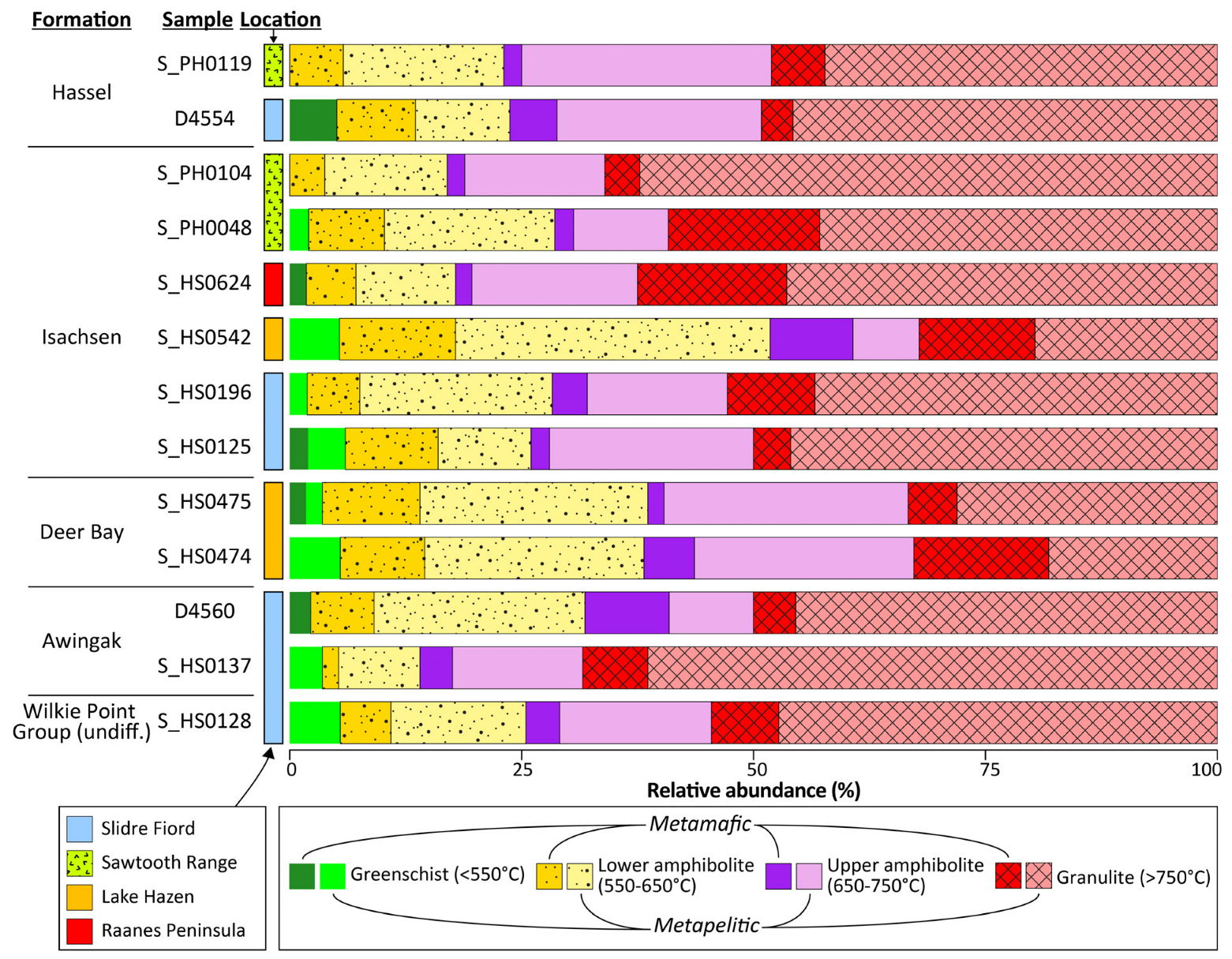
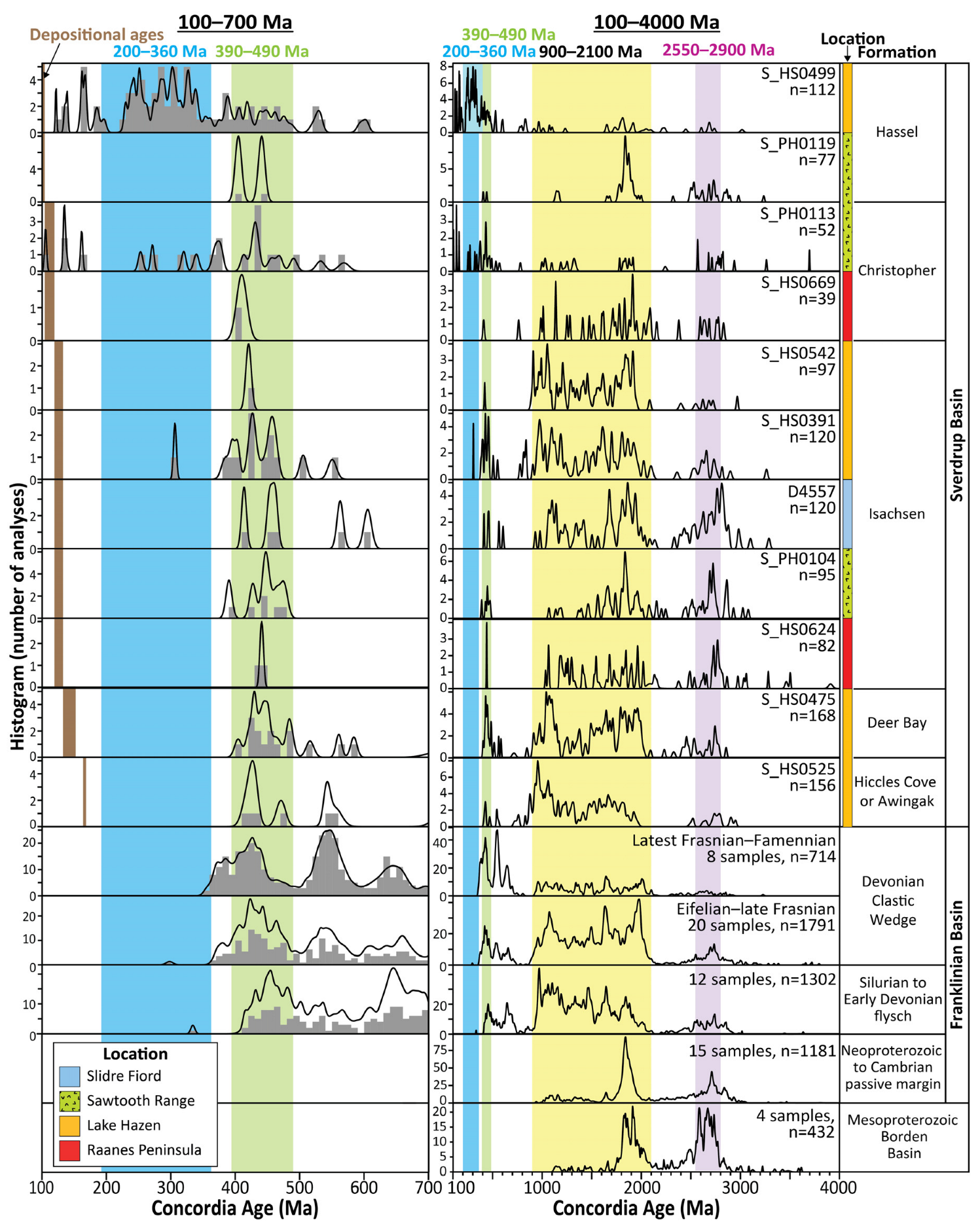
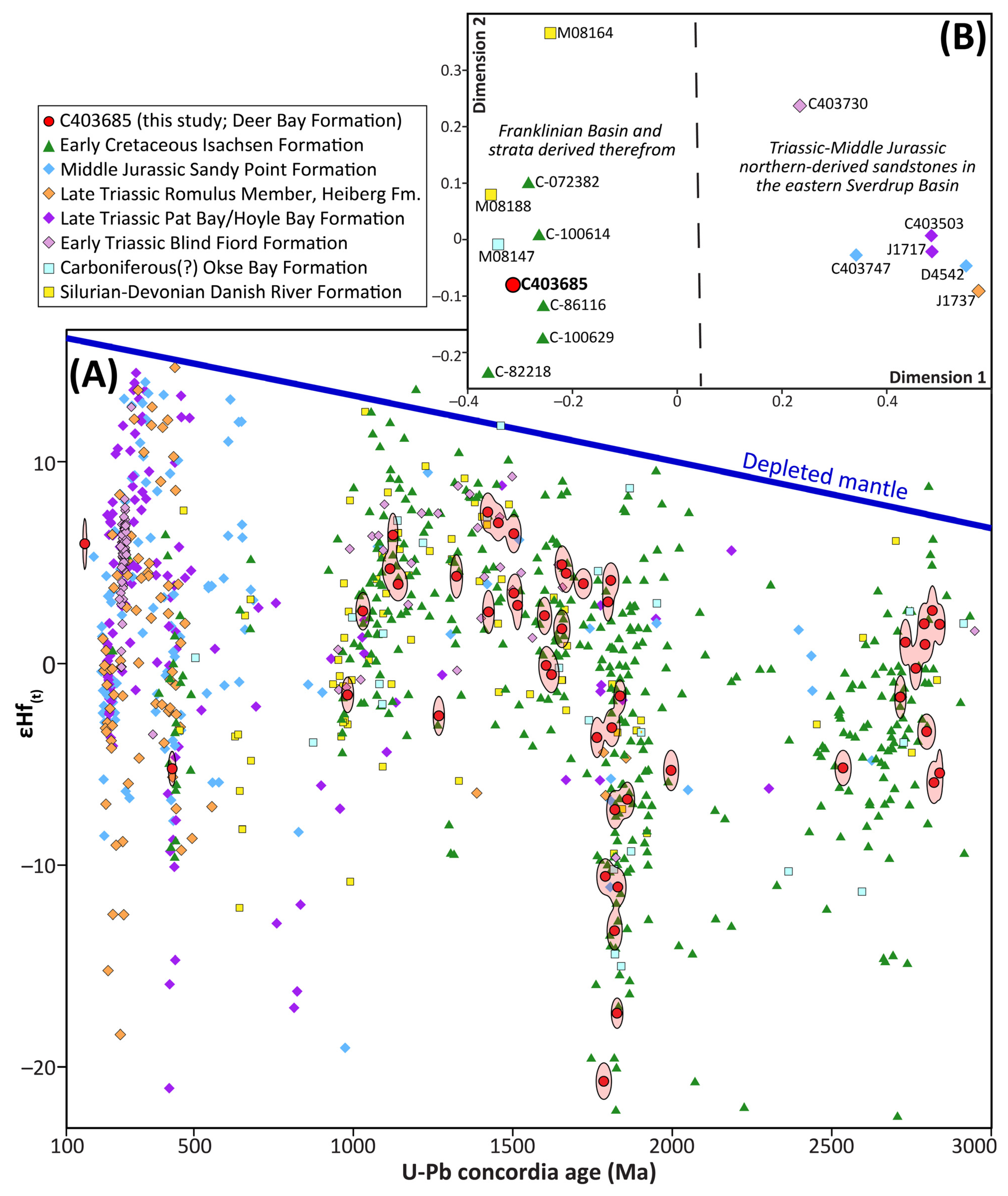
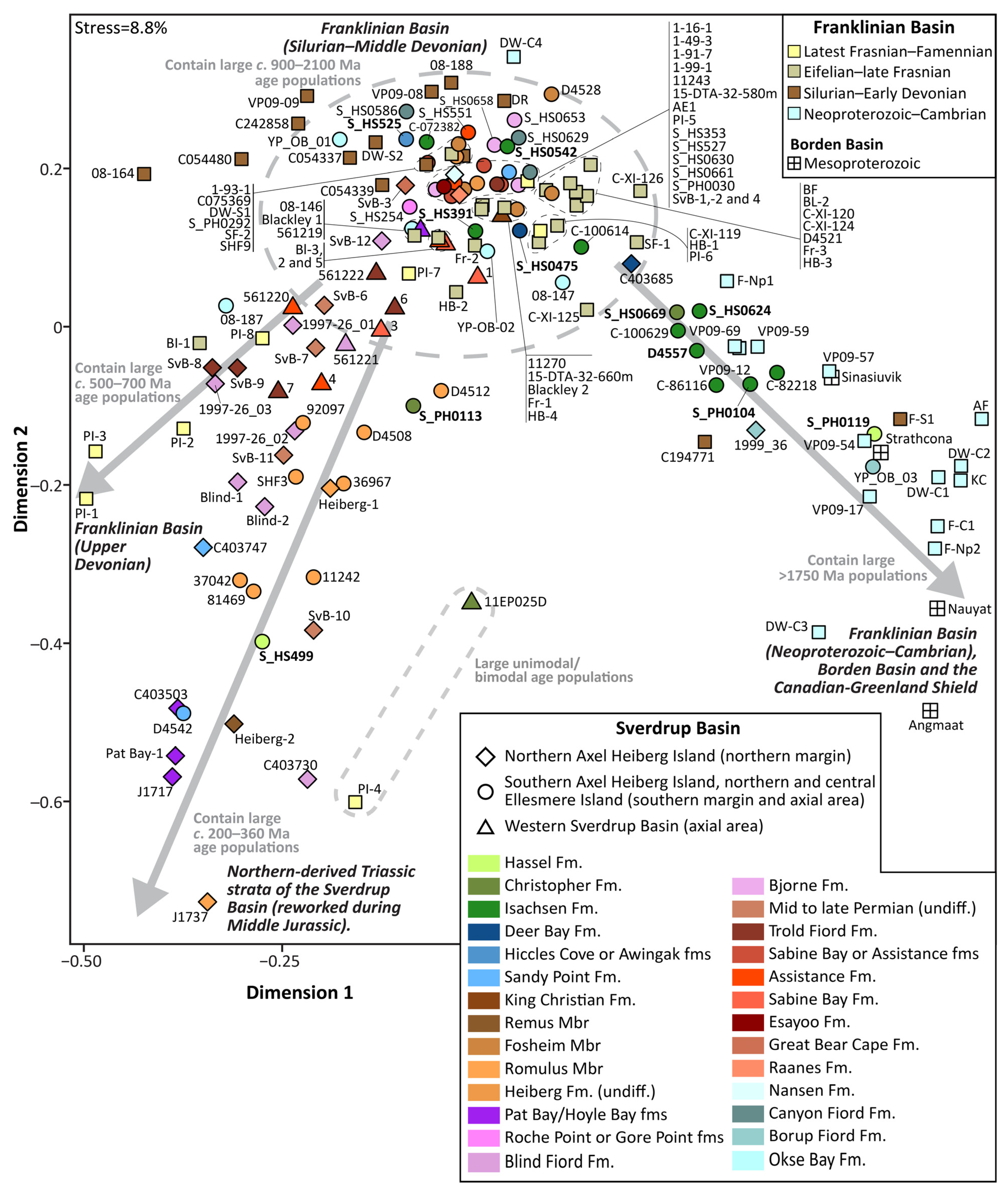
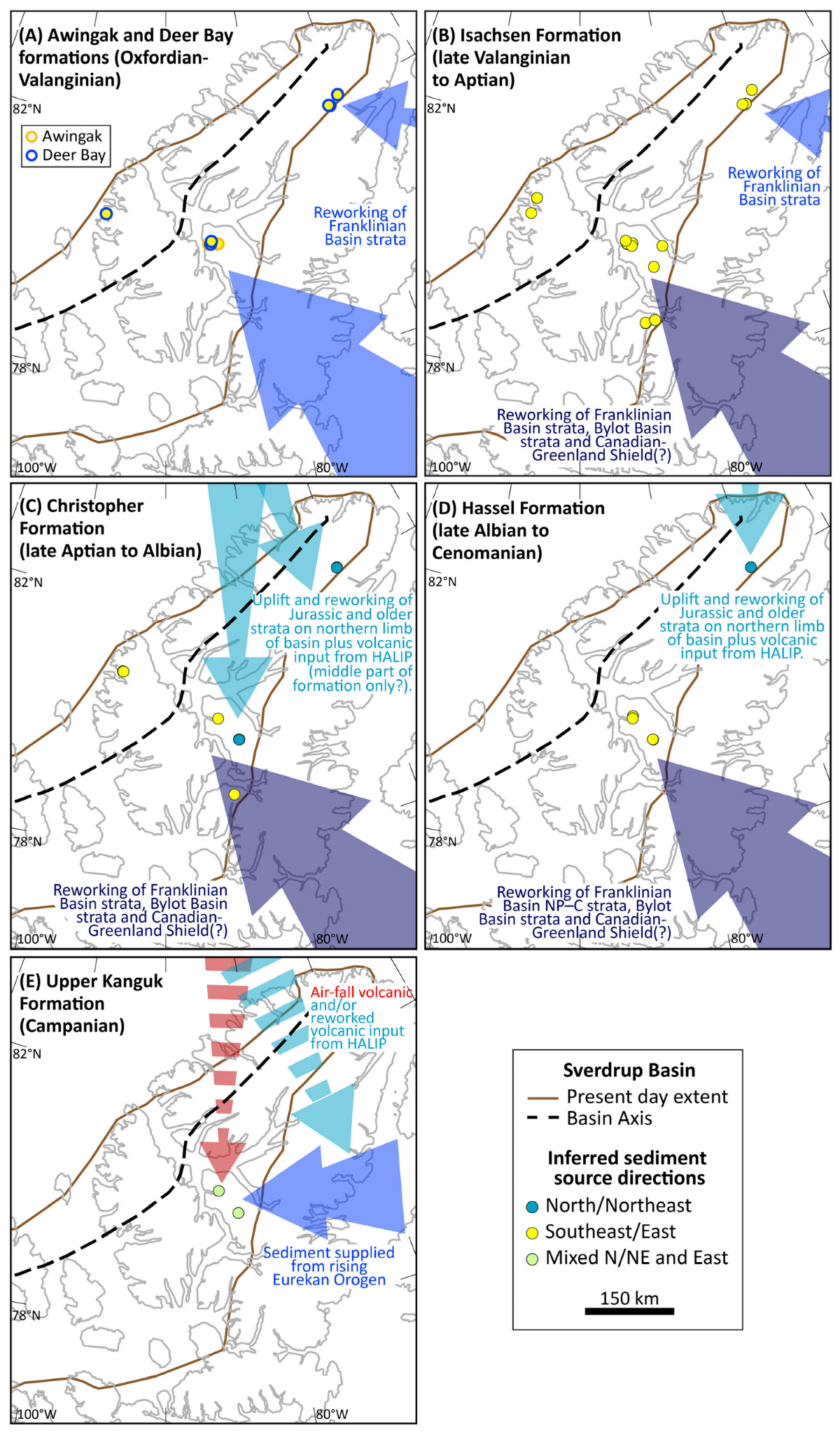
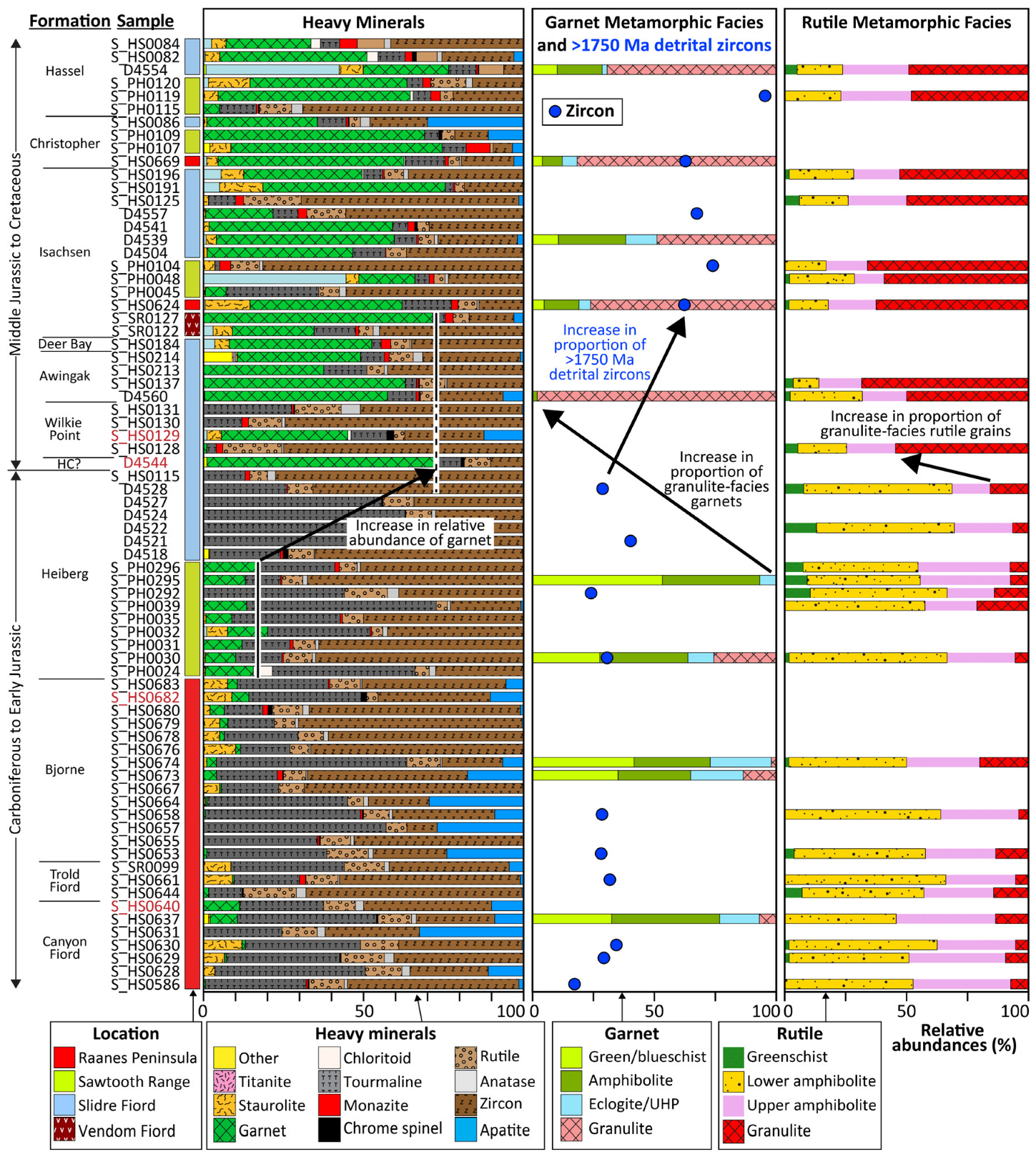
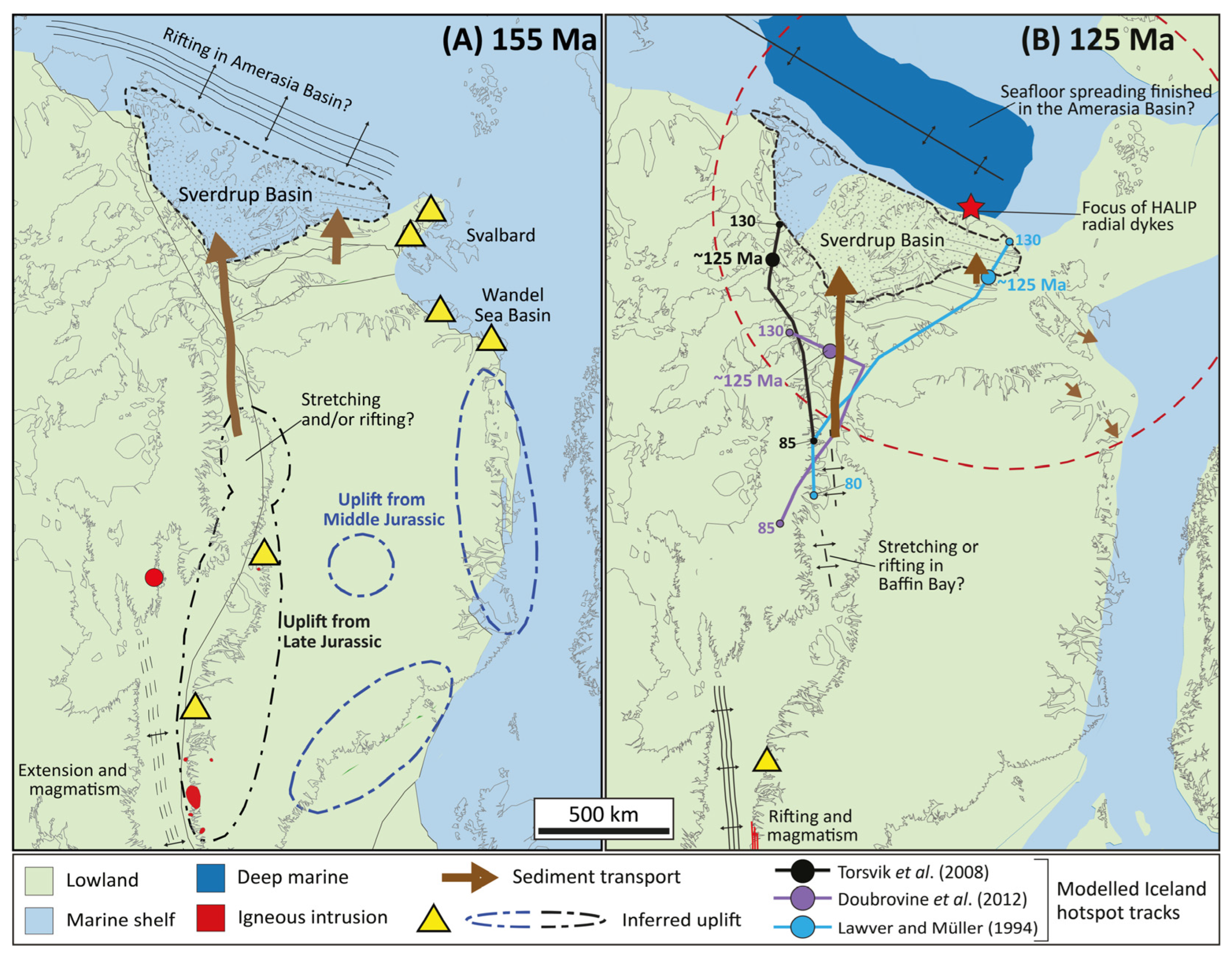
Disclaimer/Publisher’s Note: The statements, opinions and data contained in all publications are solely those of the individual author(s) and contributor(s) and not of MDPI and/or the editor(s). MDPI and/or the editor(s) disclaim responsibility for any injury to people or property resulting from any ideas, methods, instructions or products referred to in the content. |
© 2025 by the authors. Licensee MDPI, Basel, Switzerland. This article is an open access article distributed under the terms and conditions of the Creative Commons Attribution (CC BY) license (https://creativecommons.org/licenses/by/4.0/).
Share and Cite
Pointon, M.A.; Smyth, H.; Omma, J.E.; Morton, A.C.; Schneider, S.; Rippington, S.J.; Lopez-Mir, B.; Crowley, Q.G.; Frei, D.; Flowerdew, M.J. A Sediment Provenance Study of Middle Jurassic to Cretaceous Strata in the Eastern Sverdrup Basin: Implications for the Exhumation of the Northeastern Canadian-Greenlandic Shield. Geosciences 2025, 15, 313. https://doi.org/10.3390/geosciences15080313
Pointon MA, Smyth H, Omma JE, Morton AC, Schneider S, Rippington SJ, Lopez-Mir B, Crowley QG, Frei D, Flowerdew MJ. A Sediment Provenance Study of Middle Jurassic to Cretaceous Strata in the Eastern Sverdrup Basin: Implications for the Exhumation of the Northeastern Canadian-Greenlandic Shield. Geosciences. 2025; 15(8):313. https://doi.org/10.3390/geosciences15080313
Chicago/Turabian StylePointon, Michael A., Helen Smyth, Jenny E. Omma, Andrew C. Morton, Simon Schneider, Stephen J. Rippington, Berta Lopez-Mir, Quentin G. Crowley, Dirk Frei, and Michael J. Flowerdew. 2025. "A Sediment Provenance Study of Middle Jurassic to Cretaceous Strata in the Eastern Sverdrup Basin: Implications for the Exhumation of the Northeastern Canadian-Greenlandic Shield" Geosciences 15, no. 8: 313. https://doi.org/10.3390/geosciences15080313
APA StylePointon, M. A., Smyth, H., Omma, J. E., Morton, A. C., Schneider, S., Rippington, S. J., Lopez-Mir, B., Crowley, Q. G., Frei, D., & Flowerdew, M. J. (2025). A Sediment Provenance Study of Middle Jurassic to Cretaceous Strata in the Eastern Sverdrup Basin: Implications for the Exhumation of the Northeastern Canadian-Greenlandic Shield. Geosciences, 15(8), 313. https://doi.org/10.3390/geosciences15080313







